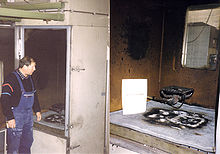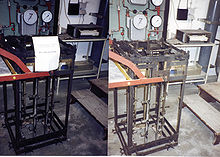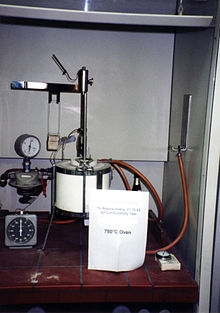- Flammability
-
 Flammable liquid warning sign
Flammable liquid warning sign
Flammability is defined as how easily something will burn or ignite, causing fire or combustion. The degree of difficulty required to cause the combustion of a substance is quantified through fire testing. Internationally, a variety of test protocols exist to quantify flammability. The ratings achieved are used in building codes, insurance requirements, fire codes and other regulations governing the use of building materials as well as the storage and handling of highly flammable substances inside and outside of structures and in surface and air transportation. For instance, changing an occupancy by altering the flammability of the contents requires the owner of a building to apply for a building permit to make sure that the overall fire protection design basis of the facility can take the change into account.
Contents
Testing
A fire test can be conducted to determine the degree of flammability. Test standards used to make this determination but are not limited to the following:
- Underwriters Laboratories UL 94 Flammability Testing
- International Electrotechnical Commission IEC 60707, 60695-11-10 and 60695-11-20
- International Organization for Standardization ISO 9772 and 9773.
- National Fire Protection Association NFPA 287 Standard Test Methods for Measurement of Flammability of Materials in Cleanrooms Using a Fire Propagation Apparatus (FPA)
- NFPA 701: Standard Methods of Fire Tests for Flame Propagation of Textiles and Films
Categorization of building materials
-
DIN4102 A2 gypsum fireproofing plaster leavened with polystyrene beads
-
DIN 4102 B1 (difficult to ignite/often self-extinguishing) Silicone caulking used as a component in firestopping piping penetration
-
DIN 4102 B3: Polyurethane foam (easy to ignite = lots of hydrocarbon bonds usually)
Materials can be tested for the degree of flammability and combustibility in accordance with the German DIN 4102. DIN 4102, as well as its British cousin BS 476 include for testing of passive fire protection systems, as well as some if its constituent materials.
The following are the categories in order of degree of combustibility as well as flammability:
Rating Degree of flammability Examples A1 100% noncombustible (nichtbrennbar) A2 ~98% noncombustible (nichtbrennbar) B1 Difficult to ignite (schwer entflammbar) intumescents and some high end silicones B2 Normal combustibility wood B3 Easily ignited (leichtentflammbar) A more recent norm is the European EN 13501-1 - Fire classification of construction products and building elements - which roughly replaces A2 with A2/B, B1 with C, B2 with D/E and B3 with F.
B3 or F rated materials may not be used in building unless combined with another material which reduces the flammability of those materials.
Important characteristics
Flash point
A material's flash point is a metric of how easy it is to ignite the vapor of the material as it evaporates into the atmosphere. A lower flash point indicates higher flammability. Materials with a flash points below 100 °F (38 °C) are regulated in the United States by OSHA as potential workplace hazards.
Vapor pressure
- The vapor pressure of a liquid, which varies with its temperature, is a measure of how much the vapor of the liquid tends to concentrate in the surrounding atmosphere as the liquid evaporates. Vapor pressure is a major determinant of the flash point, with higher vapor pressures leading to lower flash points and higher flammability.
Examples of flammable liquids
Flammable liquids include, but are not limited to:
- Gasoline / a complicated mixture of hydrocarbons that includes isomers of octane, C8H18
- Ethanol / CH3CH2OH
- Isopropanol / CH3CH(OH)CH3
- Methanol / CH3OH
- Acetone / CH3COCH3
- Nitromethane / CH3NO2
Examples of nonflammable liquids
Classification of flammability
The US Government uses the Hazardous Materials Identification System (HMIS) standard for flammability ratings, as do many US regulatory agencies, and also the US National Fire Protection Association (NFPA).
The ratings are as follows:
Rating Degree of flammability Examples 0 Materials that will not burn water 1 Materials that must be preheated before they will ignite lubricating oils, cooking oils 2 Materials that must be moderately heated or exposed to relatively high ambient temperatures before they will ignite diesel fuel 3 Liquids and solids that can ignite under almost all temperature conditions gasoline, acetone 4 Materials which will rapidly vaporize at atmospheric pressure and normal temperatures, or are readily dispersed in air and which burn readily natural gas, propane, butane Codes
Flammability
For existing buildings, fire codes focus on maintaining the occupancies as originally intended. In other words, if a portion of a building were designed as an apartment, one could not suddenly load it with flammable liquids and turn it into a gas storage facility, because the fire load and smoke development in that one apartment would be so immense as to overtax the active fire protection as well as the passive fire protection means for the building. The handling and use of flammable substances inside a building is subject to the local fire code, which is ordinarily enforced by the local fire prevention officer.
Linguistics: flammable vs. inflammable
Flammable and inflammable are synonyms and mean capable of burning. The word "inflammable" came from Latin inflammāre = "to set fire to," where the prefix "in-" means "in" as in "indoctrinate", rather than "not" as in "invisible" and "ineligible". Nonetheless, "inflammable" is often erroneously thought to mean "non-flammable". In the United States, this safety hazard is typically avoided by use of the back-formation flammable, despite its not being the proper Latin-derived term, on warning labels referring to physical combustibility.
The antonym of flammable/inflammable is non-inflammable, incombustible, or non-combustible.[1]
See also
- Fire test
- Fire protection
- Active fire protection
- Passive fire protection
- Flammable liquids
- Lower flammable limit
- Upper flammable limit
References
External links
Categories:- Fire protection
- Fire prevention
- Thermodynamics
Wikimedia Foundation. 2010.







